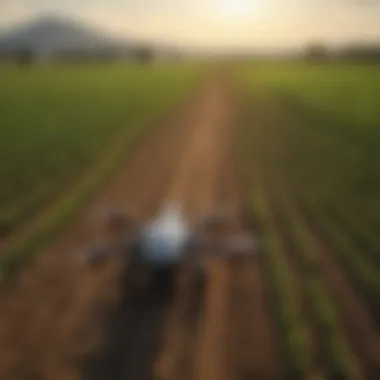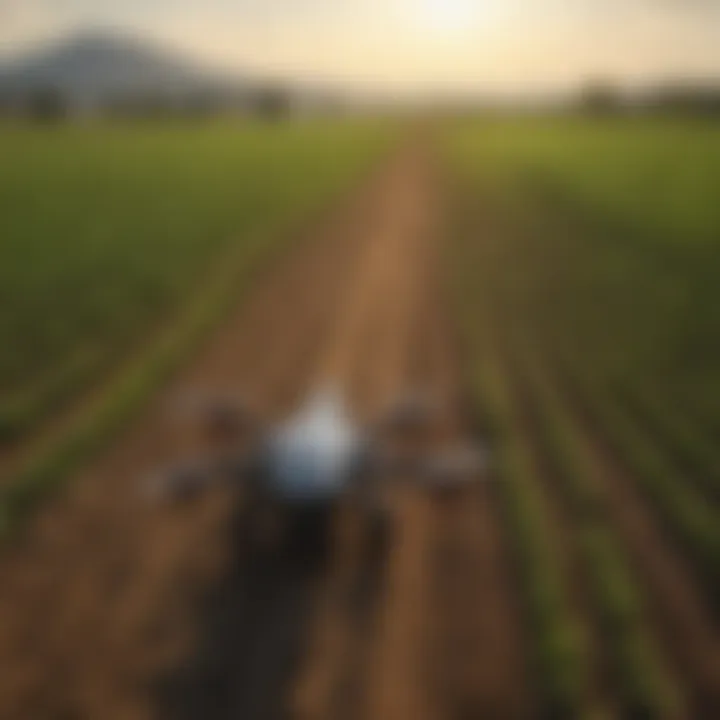Projected Global Population and Its Impact on Agriculture


Intro
The force of projections concerning global population growth generates significant attention across multiple fields, particularly in agriculture. As humanity continues to expand, anticipated population figures pose challenges that must be addressed. Understanding the interplay between population dynamics, agricultural productivity, and sustainability is essential for ensuring food security. A comprehensive analysis reveals not only the challenges but also the opportunities for innovation in this sector.
Topic Overview
Definition and Importance
The term projected global population refers to estimations of future population figures based on current trends, birth rates, death rates, and migration patterns. Its importance lies in the cascading effects population growth has on various domains, notably agriculture. An increasing population usually leads to higher food demand, which can strain existing agricultural systems if not managed properly.
Brief History and Evolution
Historically, agricultural practices evolved in response to population fluctuations. The Green Revolution of the 20th century marked a significant turning point in agricultural productivity, significantly increasing food production. However, while this revolution met the immediate needs, it also paved the way for challenges related to sustainability and environmental degradation. The need for a sustainable approach has never been more pressing as the world approaches nearly eight billion people and counting.
Key Techniques and Innovations
Sustainable Farming Practices
Sustainable farming practices aim to produce food while maintaining environmental health and ensuring social equity. Methods include:
- Crop rotation: Helps maintain soil fertility and reduce pest build-up.
- Agroecology: Utilizes ecological principles to optimize farming.
- Integrated pest management: Minimizes pesticide use by adopting a holistic view of pests and their ecosystems.
Advanced Agronomic Technologies
Innovation plays a crucial role in adapting agriculture to population pressures. Some major advancements include:
- Precision agriculture: Uses technology to monitor and manage field variability in crops.
- Biotechnology: Genetically modified organisms (GMOs) can improve crop resilience and yield.
- Vertical farming: Utilizes limited space through stacked layers, reducing land use.
Practical Applications
Step-by-Step Guides
- Assess local conditions: Understand soil, climate, and water availability.
- Select appropriate crops: Choose those that meet both market and environmental needs.
- Implement sustainable practices: Incorporate methods like crop rotation and organic fertilizers.
- Monitor and adjust: Use data from precision agriculture to make informed decisions.
Case Studies or Real-World Examples
Urban agriculture initiatives in cities like New York and Singapore exemplify innovative approaches to feed growing populations. They integrate sustainability by utilizing rooftops and vacant lots for food production, thus shortening supply chains and reducing carbon footprints.
"Investing in sustainable agricultural practices today, will not only ensure food security for future generations but also protect our planet."
The future of agriculture must be guided by an understanding of population dynamics and a commitment to sustainable practices. As professionals engage with these insights, they prepare themselves to navigate the challenges and opportunities that lie ahead.
Understanding Global Population Projections
Understanding global population projections is fundamental in exploring the implications for agriculture and sustainability. Population projections concern estimates of future population size and structure, based on current trends and demographic factors. As the world population increases, this knowledge becomes critical in preparing for future agricultural demands and sustainability challenges.
Population projections provide insights into potential growth patterns in various regions, influencing food security, resource management, and economic policies. Accurate projections help governments and organizations anticipate changes in agricultural demands. This understanding leads to informed decision-making about resource allocation and agricultural technology advancements.
Moreover, recognizing the importance of demographic trends is crucial for agricultural infrastructures and practices. For instance, areas anticipating rapid population growth may need to innovate farming techniques to keep pace with demand. It also emphasizes the need for sustainable practices to ensure that future generations have access to the resources they need.
In essence, comprehending population projections enhances our ability to strategize effectively for future agricultural and environmental scenarios.
Definition of Population Projections
Population projections are estimates made using statistical techniques to forecast future population characteristics based on current data and trends. They are essential for understanding how many people will inhabit a region at a specified time in the future. These projections generally consider factors like birth rates, death rates, and migration patterns. By modeling these variables, demographers can provide scenarios that reflect possible futures.
This process enables policymakers to allocate resources effectively. For example, if a region expects significant population growth, targeted investment in agriculture and infrastructure is essential.
Historical Population Trends
Examining historical population trends sheds light on demographic shifts over time. Since the early 20th century, global population has experienced unprecedented growth, doubling several times. Between 1950 and 2020, the world population surged from approximately 2.5 billion to nearly 7.8 billion people. This rapid increase emphasizes changes in health, technology, and agricultural productivity.
Analyzing trends also informs expectations for future growth. Regions such as Asia and Africa have seen significant increases, while some developed countries face stagnation or decline. Understanding these trends allows for better planning in agriculture to meet future demands.
Key Terminologies in Demography
In demography, precise terminology facilitates clear communication around population studies. Some crucial terms include:
- Fertility Rate: The average number of children a woman is expected to have in her lifetime.
- Mortality Rate: The number of deaths per 1,000 individuals in a population.
- Migration: The movement of people from one place to another, influencing population size and composition.
Understanding these terms helps stakeholders in agriculture and sustainability sectors navigate the complexities of population dynamics.
Accurate demographic data informs better strategies for food security and sustainability practices.
Current Statistics and Projections
Understanding the current population statistics and trends is key for farmers and agricultural enthusiasts. Accurate data on population projections helps stakeholders anticipate future challenges in food security and resource management. This section outlines how understanding these projections can drive better decisions in agricultural practices.
Global Population Estimates
The current global population is estimated to be around 8 billion people and is projected to reach approximately 9.7 billion by 2050. Such rapid growth places enormous pressure on agricultural systems globally. According to the United Nations, regions such as Sub-Saharan Africa are expected to see some of the highest increases, while certain parts of Europe may experience stagnation or decline in population.
Understanding these estimates allows for targeted agricultural investments. With more people to feed, farming practices must adapt to be more efficient and productive. High population regions can benefit from tailored strategies that focus on food production and sustainability.
Projected Growth by Region
Population growth is not uniform across the globe. Different regions present distinct challenges and opportunities. For instance:
- Asia: Continues to experience significant urbanization, affecting traditional farming practices. Countries like India and China face demands for increased food supply.
- Africa: The population is set to double by 2050, raising questions about land use and natural resource management. Ensuring food security in these areas will require innovation in agricultural practices.
- Latin America: This region is seeing slower growth, but urbanization impacts rural economies and farming.
- Europe and North America: These areas may see a stable or decreasing population, leading to shifts in agricultural labor markets and crop demand.
By focusing on regional differences, farmers can gain insights into market needs and optimize their agricultural techniques to meet future demand.


Factors Influencing Population Growth
Understanding the factors that lead to population growth is critical for planning and adaptation in agriculture. Some notable factors include:
- Fertility Rates: In many developing countries, higher fertility rates contribute significantly to population growth. Conversely, developed nations often see lower birth rates.
- Health Care Improvements: Advances in health care and sanitation have led to lower mortality rates, especially among infants, boosting population figures.
- Migration Trends: Migration can significantly affect demographics, often increasing population numbers in urban areas, which impacts local farming and food distribution systems.
- Economic Development: Economic stability often correlates with lower fertility rates. As nations develop, families may choose to have fewer children, affecting long-term projections.
By grasping these factors, agricultural practices can evolve to meet not just current demands but also adapt to future demographic changes.
"The global landscape is shifting rapidly. It is crucial that we not only understand where we stand now but also where we are headed."
In summary, the projections of global population dynamics significantly impact agricultural practices and sustainability efforts. Stakeholders must take these statistics seriously to ensure effective food security strategies and sustainable agricultural methods.
Demographic Shifts and Their Importance
Demographic shifts refer to changes in the characteristics of a population over time. These shifts are crucial for understanding how societies evolve and adapt in response to various factors, including economics, health developments, and migration patterns. Recognizing the magnitude of such shifts is essential, particularly in the context of agriculture and sustainability. It aids in predicting the demands and challenges that the agricultural sector may face as populations age, youth demographics change, and migrations occur.
As populations age, the labor force may decline, impacting agricultural productivity. Conversely, an increase in the youth population can provide a fresh workforce that may also drive demand for modern agricultural practices. Ultimately, comprehending these dynamics allows investors, policymakers, and farmers to strategically plan and implement solutions that could address future challenges effectively.
Additionally, demographic shifts also contribute to market demands that influence food production and sustainability. The preferences and buying habits of different age groups can lead to varied agricultural practices and priorities. Addressing these changes proactively may help ensure food security throughout the developing stages of these demographic trends.
Aging Population Dynamics
The aging population poses significant implications for agricultural practices. As individuals age, their ability and willingness to engage in physical labor often declines. This reality can result in fewer employees in agriculture, potentially leading to labor shortages. As a result, farms may need to explore automation and other technologies to maintain production levels.
Producing food to meet the nutritional needs of an older demographic also requires specific considerations. Older individuals may prefer easier-to-consume foods, which could lead to shifts in production methods.
"Understanding how demographics affect agriculture is essential to adapting practices and ensuring sustainability."
Youth Population Trends
Youth population trends indicate a vibrant segment of the population that can significantly influence agricultural dynamics. Young people are often crucial adopters of innovative agricultural technologies. Their engagement in sustainable farming practices can also lead to improved environmental outcomes. However, attracting youth to farming is crucial to sustain agricultural sectors in many regions.
It is vital to create opportunities for young individuals in agriculture, such as access to education on modern practices and financial support for starting farms. Organizing community programs to foster interest in agricultural careers can counteract negative perceptions and promote farming as a viable career option.
Migration Patterns
Migration patterns create another layer of complexity in demographics impacting agriculture. As people migrate, whether due to conflict, climate change, or economic opportunities, communities can see significant shifts in their agricultural practices. Migrants often bring their agricultural knowledge and preferences, which can influence local farming practices and crop choices.
It’s essential to integrate these diverse agricultural practices into local systems. Policies that recognize the contributions of migrants can enhance the agricultural landscape. Furthermore, stable opportunities for migrants within agriculture can alleviate pressures on food systems in host communities.
Urbanization and Its Effects
Urbanization is a critical aspect of global population growth, shaping not only demographic trends but also agricultural practices and sustainability initiatives. The migration from rural to urban areas presents myriad challenges and opportunities for communities, farmers, and policymakers alike. Addressing the implications of urbanization is essential to creating resilient food systems capable of supporting a growing population.
Urban Growth Rates
Urban growth rates reflect how quickly cities expand as people relocate from rural areas. These rates are not uniform across the globe. For instance, cities in Asia and Africa are experiencing some of the highest growth rates, driven by factors such as employment opportunities, better living conditions, and access to services. According to the United Nations, it is estimated that by 2050, about two-thirds of the world's population will be living in urban areas. This shift towards urbanization raises significant considerations for how food is produced, distributed, and consumed.
- Factors Influencing Urban Growth Rates:
- Economic opportunities attract rural populations to cities.
- Improved transportation networks facilitate movement.
- Social factors such as education and healthcare access also play a role.
Understanding these growth patterns is crucial for developing effective strategies to ensure food security and sustainability.
Implications for Agriculture
Urbanization significantly impacts agriculture, both positively and negatively. On one hand, urban areas create demand for food, increasing the necessity for efficient agricultural practices. On the other hand, the expansion of cities often encroaches upon arable land, leading to a reduction in agricultural space.
Quote: "Urban sprawl often translates to loss of prime farmland, posing a challenge to food production stability."
Several implications for agriculture include:
- Increased Demand: Urban populations require consistent food supply. This necessitates advances in production methods.
- Land Use Changes: As cities expand, agricultural land can diminish, requiring innovation in agricultural techniques.
- Food Transportation Needs: With more food needing to be shipped into urban centers, logistics and transportation become more critical.
Farmers must adapt to these transformations to meet the evolving demands presented by urbanism.
Infrastructure Challenges
The rapid rate of urbanization creates significant infrastructure challenges that impact agriculture adversely. Essential components like transportation, water supply, and waste management systems often struggle to keep up with the growing demands of urban populations.
Infrastructure challenges can manifest in several ways:
- Transportation: Inefficient transport systems complicate the movement of produce from rural farms to urban markets.
- Water Scarcity: Urban areas may prioritize water usage for residential and commercial purposes, leaving agricultural areas with insufficient resources.
- Waste Management Issues: As urban areas grow, the management of agricultural waste — as well as food waste generated in cities — can become increasingly problematic.
These challenges underline the need for coordinated planning and investment in infrastructure to mitigate the adverse effects of urbanization on agriculture. Overall, addressing urbanization's multifaceted impacts is crucial for achieving sustainable agricultural practices and ensuring food security as population dynamics evolve.
Food Security in the Context of Population Growth
Food security is a critical concern in the context of rising global population. The increasing number of people places heightened demand on agricultural systems to produce sufficient food. As populations grow, the fragility of food supply chains and the capacity of current agricultural practices to meet this demand come into sharper focus. Understanding food security dynamics is essential for ensuring sustainable agricultural practices.
Current Food Supply and Demand
The relationship between current food supply and demand is complex. Global agricultural production must keep pace with population growth to maintain food security. The Food and Agriculture Organization (FAO) estimates that the world must increase food production by about 70% by 2050. This goal requires optimizing production methods, enhancing efficiency in food production, and reducing waste.
Factors affecting food supply include climatic conditions, land availability, and resource input such as water and technology. Crop yields can vary significantly year to year due to weather extremes, pests, and diseases. Additionally, consumer preferences are evolving, impacting demand patterns. For instance, there is increasing interest in plant-based diets, which requires adjustments in agricultural output and distribution models.
Challenges to Food Distribution
Food distribution presents significant challenges in achieving food security. Even with adequate production, food does not always reach those in need. Issues such as infrastructure deficits, logistic inefficiencies, and economic barriers restrict access.
Some key challenges include:
- Infrastructure Limitations: Poor transportation networks hinder the movement of food from producers to consumers. In many regions, rural areas lack the transportation and storage facilities necessary for efficient distribution.
- Economic Barriers: High poverty levels in certain areas can restrict individuals' access to food. The cost of food can become prohibitively high, leading to food insecurity despite adequate overall supply.
- Political Factors: Trade restrictions and geopolitical instability can disrupt food supply chains at both local and international levels.


The Role of Agricultural Innovation
Innovation in agriculture is vital for addressing the dual challenges of food security and a growing population. Advancements in technology can increase productivity and reduce environmental impacts. For instance, precision agriculture employs data-driven techniques to optimize inputs and yields while minimizing waste.
Several relevant innovations include:
- Biotechnology: Genetically modified organisms (GMOs) can enhance crop resistance to diseases and increase yield potential, which may be critical in feeding future populations.
- Sustainable Practices: Techniques such as agroforestry and permaculture foster resilience in agricultural systems while maintaining ecological balance.
- Digital Farming: Use of drones and sensors helps farmers monitor crop health and resource use, leading to more informed decision-making.
Advances in agricultural technology could be the key to unlocking greater food security in the face of rising global demands.
Looking ahead, it becomes increasingly clear that food production must evolve. Addressing food security amid population growth necessitates renewed focus on innovation, distribution efficiency, and sustainable practices.
Sustainability Challenges in a Growing Population
The discussion around sustainability challenges in a growing population holds significance for both agricultural practices and environmental health. As the global population rises, the strain on resources increases. The challenge is to balance agricultural productivity with sustainable practices that protect the environment. Hence, examining how agriculture impacts sustainability will assist in identifying solutions that address these challenges effectively.
Environmental Impact of Agriculture
The environmental impact of agricultural practices is profound. Currently, agriculture contributes significantly to greenhouse gas emissions, land degradation, and biodiversity loss. Practices such as deforestation for farmland or excessive fertilizer use lead to soil erosion and nutrient runoff into waterways. These actions not only harm ecosystems but also threaten food security in the long run.
Key Points on Environmental Impact:
- Greenhouse Gas Emissions: Agricultural activities release methane and nitrous oxide, potent greenhouse gases. Finding methods to decrease these emissions is crucial for mitigating climate change.
- Biodiversity Loss: Modern agriculture often relies on monoculture, reducing genetic diversity. Diversifying crops could improve ecosystem resilience.
- Soil Degradation: Over-farming and use of chemicals degrade soil health. Adopting organic practices can enrich soil and increase productivity.
"Sustainable agricultural practices can reconcile the need for increased food production with the preservation of natural ecosystems."
Water Resource Management
Water scarcity is increasingly recognized as a pressing issue linked with population growth and agricultural demands. Effective water resource management is key to ensuring a sustainable supply of this vital resource.
Agricultural water use is high, often constituting about 70% of global freshwater withdrawals. This leads to over-extraction of water resources, especially in arid regions. Some strategies for better management include:
- Irrigation Efficiency: Utilizing drip irrigation and rainwater harvesting can enhance water use.
- Crop Selection: Choosing drought-resistant crops can lessen the demand for water.
- Water Recycling: Implementing procedures for treating and reusing agricultural runoff can conserve fresh water.
Land Use Changes and Pressures
Land use changes due to increasing population present another sustainability challenge. Expanding urban areas often consume valuable agricultural land. This creates pressures on rural communities and local food systems.
Addressing land use challenges involves:
- Zoning Regulations: Planning urban development while protecting agricultural lands is important.
- Agroforestry: Combining agriculture with forestry can optimize land use and enhance productivity.
- Urban Agriculture: Promoting farming within urban settings can provide fresh produce and reduce food miles.
Strategies for Adapting to Population Growth
Adapting to a growing global population is critical. As the numbers rise, the pressure on food production and sustainability intensifies. It is vital for agriculture to evolve and sustain itself to meet these rising demands. The strategies outlined below aim to provide a pathway for effective adaptation.
Advancing Agricultural Practices
Innovative agricultural practices become essential in this changing world. Traditional farming methods may not suffice in meeting the food needs of the future. To advance agricultural practices, farmers must adopt precision farming techniques. This involves utilizing technology like GPS, IoT sensors, and drones. They can help in monitoring crop health, soil quality, and water usage. Also, the use of data analytics allows for more informed decision-making.
Improved crop varieties can play a major role in advancement. Plants that are resistant to pests, diseases, and climate extremes can enhance yields. Farmers must stay informed about research in agricultural biotechnology. Engaging with advancements can lead to better harvests and more resilient farming systems.
Promoting Sustainable Farming Techniques
Sustainable farming techniques are crucial for maintaining ecological balance while increasing productivity. Techniques such as crop rotation and agroecology can enhance soil health. These methods respect the natural ecosystem and involve less chemical input.
Farmers are encouraged to explore organic farming as a way to promote sustainability. Organic methods not only reduce chemical impact but can also yield healthier produce, appealing to increasingly health-conscious consumers.
Incorporating permaculture principles also promotes resilience. By mimicking natural ecosystems, farmers can create sustainable systems that produce food without intensive resource inputs. This can lead to self-sustaining farms that adapt natural cycles and patterns for agricultural success.
Enhancing Food Waste Reduction Strategies
Reducing food waste is one of the most effective strategies to meet the challenges of population growth. Reducing waste at all levels—from production to consumption—can significantly increase food availability. Initiatives can be put in place to better manage surplus produce.
Programs to educate consumers on proper storage and cooking techniques can also help minimize waste. Supermarkets and restaurants can implement inventory management systems to reduce overstocking.
"The reduction of food waste is not simply a matter of efficiency; it represents a vital opportunity to increase food supply without the need for additional agricultural expansion."
In summary, strategies for adapting to population growth include advancing agricultural practices, promoting sustainable farming techniques, and enhancing food waste reduction strategies. These approaches are essential for developing a resilient food system capable of facing the challenges ahead.
The Role of Technology in Agriculture
Technology has become essential in transforming the agricultural landscape. As global population rises, the demand for food increases significantly. This scenario brings forth the necessity to rethink current agricultural practices. Innovative technologies not only enhance productivity but also ensure sustainability in food production. Farmers can now harness data and cutting-edge tools to maximize efficiency and minimize environmental impacts.
Precision Farming Techniques
Precision farming is a modern approach that utilizes data analytics and GPS technology. This method allows farmers to monitor crop health, soil conditions, and weather patterns accurately. By using precision agriculture, farmers can apply fertilizers and pesticides more effectively. This targeted approach reduces waste and improves crop yield. Tools such as drones and soil sensors are becoming common in fields, providing real-time information that informs decision-making. Farmers can make better choices regarding resource allocation, benefiting both their land and the environment.
Biotechnology Applications
Biotechnology holds great promise for agriculture. This field involves modifying organisms for better agricultural outputs. Genetic engineering, for instance, can create crops that are resistant to pests and diseases. These modifications can lead to higher yields and reduced reliance on chemical treatments. The use of genetically modified organisms (GMOs) remains a topic of debate. However, the potential benefits include increased food security against a backdrop of rising populations. Moreover, biotechnology can help in developing crops that require less water, making them suitable for arid regions. This adaptability is crucial in the face of climate change challenges.
Farm Automation and Robotics
Automation in farming is rapidly evolving. Robots and automated systems perform tasks that were once labor-intensive and time-consuming. These machines can plant, irrigate, and harvest crops with precision. For example, robot tractors equipped with AI can navigate fields autonomously while optimizing conditions for crop growth. This advancement reduces labor costs and addresses workforce shortages in rural areas.
Automation also extends to monitoring crop conditions. Sensors can track moisture levels and nutrient content, alerting farmers to necessary interventions.
"By integrating automation, farms can not only improve productivity but also enhance sustainability through efficient resource use."
The potential of technology in agriculture is vast, aligning with the pressing need for innovative solutions. It's essential to continually assess emerging technologies and their applicability within the context of sustainable practices. As we move forward, these advancements will be key to addressing the demands of a growing population while safeguarding the environment.
Global Policies and Initiatives


Policies on a global scale play a crucial role in addressing the challenges of a rising population and its implications for agriculture and sustainability. These policies guide collective actions and strategies across nations, aiming to enhance food security while conserving natural resources. An effective global policy framework can promote cooperation, facilitate knowledge exchange, and drive innovation in agricultural practices, which is essential to meet food demands of future generations.
International Cooperation Models
The efforts to tackle global population-related issues are often predicated on international cooperation. Models of cooperation range from bilateral agreements to multilateral partnerships, such as the United Nations Framework on Climate Change (UNFCCC) and the Food and Agriculture Organization (FAO). These platforms create a space for countries to share best practices, leverage resources, and coordinate efforts in research and development.
Collaboration can lead to measurable benefits including:
- Increased access to technology for developing nations.
- Enhanced research funding for sustainable agricultural innovations.
- Commitment to global standards in food safety and environmental management.
International cooperation also fosters a sense of shared responsibility, encouraging countries to align their national interests with global sustainability goals.
National Policies on Population and Agriculture
At the national level, tailored policies are necessary to effectively address the unique challenges presented by population growth in agriculture. These may involve regulations on land use, subsidies for sustainable practices, and initiatives that support smallholder farmers. For instance, countries like India have implemented the National Mission on Sustainable Agriculture, which aims to increase productivity while ensuring the conservation of resources.
It is vital that such policies are:
- Evidence-based, employing data analysis to project needs.
- Inclusive, considering the voices of marginalized communities.
- Adaptive, responsive to changing climatic and economic conditions.
By focusing on these aspects, national policies can effectively mitigate the pressures of population growth on agricultural systems.
Impact of Global Agreements on Food Security
Global agreements shape how countries respond to food security challenges. For example, the Paris Agreement highlights the interconnections between climate change and food production. Countries are thus compelled to develop agricultural practices that not only meet food demands but also reduce greenhouse gas emissions.
These agreements can have several impacts:
- Resource Allocation: They promote investment in sustainable agriculture by encouraging governments to prioritize related initiatives.
- Guideline Development: Provide frameworks for best practices in food production and land preservation.
- Monitoring and Reporting: Establish accountability measures for national commitments to combat food insecurity.
In summary, global policies and initiatives are not merely guidelines; they embody the collective will to leverage collaboration in mitigating the challenges posed by population growth. A comprehensive approach that includes international cooperation, national policies, and global agreements will be foundational to achieving a sustainable agricultural future.
Case Studies from Different Regions
In order to fully appreciate the multifaceted relationship between global population growth and agricultural practices, it's essential to examine real-world case studies from different regions. Each region presents unique challenges and opportunities that stem from local demographics, geography, and economic conditions. Through these case studies, we can understand how various nations are responding to the pressures of population growth on their agricultural systems. Insights gained from these real-life examples can inform policy-making and farming strategies worldwide.
Asia's Population Dynamics and Agriculture
Asia is currently home to more than half of the world’s population, and its dynamics are driving significant changes in agricultural practices. Countries like China and India face the dual challenge of high population density and limited arable land. For instance, the Yangtze River Delta region in China has a burgeoning urban population which increases competition for land that was historically used for rice cultivation. As urbanization spreads, farmers are shifting toward more intensive agricultural methods to maximize yield per unit area.
Additionally, India’s Green Revolution has led to the adoption of high-yielding crop varieties. This transformation however raises concerns regarding environmental sustainability, particularly in relation to water usage and chemical fertilizers. The constant need to improve food security for such a vast population underscores the importance of innovation in agricultural methodologies. Hence, technology such as precision farming techniques is becoming crucial.
Africa's Agricultural Challenges Amid Population Growth
Africa presents a complex scenario with its expanding population and associated agricultural challenges. The continent's agricultural sector is faced with multiple hurdles, such as climate change, inadequate infrastructure, and various socio-economic factors. Countries like Nigeria, for example, are experiencing rapid population growth, currently projected to reach 400 million by 2050.
The reliance on subsistence farming means that many families remain vulnerable to food insecurity. The use of traditional farming methods limits their ability to adapt to changing conditions. However, recent initiatives aim to modernize agriculture in the region. Through investments in agricultural education, farmers are starting to adopt better practices, which include conservation agriculture. Programs that enhance access to water and introduce new crop varieties that are resilient to drought can also have a significant impact.
“With the right investments and support, Africa has the potential not only to feed its own population but also to impact global food security positively.”
North America's Technological Innovations in Agriculture
North America stands out for its innovative approach to agriculture, largely influenced by technological advancements. In the United States, for instance, the adoption of biotechnology and digital farming has transformed the agricultural landscape. Farmers are utilizing data analytics and biotechnology to increase yield and efficiency. This technology-driven approach allows for the cultivation of genetically modified crops, which can resist pests and diseases.
Moreover, precision agriculture is gaining traction across the continent. Techniques such as drone monitoring and soil moisture sensors offer farmers insights into crop health, enabling catered responses to their needs. This has led to decreased resource use - water and fertilizers - compared to traditional farming methods.
In Canada, initiatives to integrate sustainability into agricultural practices are also prominent. Programs focused on sustainable farming are increasingly common, aiming to balance productivity with environmental stewardship. These countries illustrate that with continuous investment in technology, agriculture can thrive amidst growing populations.
Future Considerations for Global Demography
Understanding future considerations for global demography is crucial as it sheds light on how population trends will shape agriculture, food security, and sustainable practices. The dynamics of population growth and shifts in demographics can significantly influence resource allocation and agricultural production methods.
Long-term Population Projections
Population projections extend beyond mere numbers; they encompass the anticipated age distribution, geographic distribution, and urban versus rural population ratios. The United Nations projects that the world population will reach approximately 9.7 billion by 2050. This rise presents various challenges such as increased demand for food, water, and energy.
Factors that drive population growth include fertility rates, life expectancy, and migration patterns. For instance, regions in sub-Saharan Africa may experience the fastest growth, altering the economic landscape and putting pressure on agricultural systems. Understanding these projections is essential for farmers and stakeholders as they devise strategies to meet rising food demands while considering resource limitations.
Evolving Trends in Agriculture
As demography evolves, so do agricultural practices. Farmers must adapt to changing consumption patterns and technologies to thrive under increased pressure. Population growth often leads to urbanization, where more people move to cities. This shift creates a greater demand for local food production. Adapting to urban agriculture can mitigate issues related to food transportation and carbon emissions.
Farmers are increasingly embracing precision agriculture. This involves using data analytics and smart technologies to optimize yield and reduce resource waste. Additionally, agroecological practices which emphasize biodiversity and natural resource conservation are gaining traction. These evolving trends highlight the need for innovative farming methods that align with sustainable development goals.
The Need for Continuous Research
Continual research is a pillar for addressing the multifaceted challenges posed by a growing population. Research should focus on developing sustainable agricultural methods, improving crop resilience to climate change, and understanding soil health better. As population dynamics change, the agricultural sector must dynamically respond through innovation and adaptation.
Furthermore, investing in research opens up pathways for international collaboration and knowledge exchange. Countries facing similar challenges can share best practices and solutions to enhance food security. By fostering a culture of continuous learning and adaptation, stakeholders can better manage the implications of demographic changes.
"Long-term projections and ongoing research are essential to prepare for the future challenges of global population growth, especially in agriculture and sustainability."
The interplay between demography and agriculture is endlessly complex. It requires a robust understanding of the underlying factors that drive change. By staying informed and adaptable, the agricultural community can help ensure that food systems remain sustainable, equitable, and capable of supporting future generations.
Concluding Thoughts
As we conclude our exploration into the intricate relationship between the projected global population and its implications on agriculture and sustainability, it becomes clear that this topic is not only relevant but essential. The rapid increase in population places significant demands on agricultural systems, necessitating a look into sustainable practices and innovative farming techniques to ensure food security for future generations. Understanding these links helps guide both policy-making and practical approaches within the agricultural sector.
Summary of Key Points
- Global Population Trends: The ongoing shifts in demographic structures present both challenges and opportunities. Regions with fluctuating growth rates will experience varying needs for agricultural adjustment and support.
- Food Security: As populations grow, maintaining a stable food supply will require better distribution systems and innovative solutions to reduce waste.
- Sustainability Practices: Adopting environmentally responsible practices will not only mitigate adverse impacts on ecosystems but also enhance long-term agricultural productivity.
- Technological Advancements: Precision agriculture, biotechnology applications, and farm automation serve as essential tools in meeting the demands of a growing population while minimizing environmental footprints.
- Policy and Cooperation: National and international cooperation is vital to ensuring a cohesive response to the challenges posed by demographic changes.
By recognizing these key points, stakeholders can make more informed decisions that help in shaping resilient agricultural practices.
Final Reflections on Agriculture and Population
The journey ahead will require adaptability and foresight. The intersection between agriculture and population dynamics demands constant evaluation and adjustment to strategies utilized in farming.
- Importance of Research: Continuous research is crucial to address emerging issues, such as climate change effects and resource scarcity. Research ensures that agricultural practices evolve alongside demographic shifts.
- Community Engagement: Farmers and agricultural professionals must engage with local communities to understand their needs better. This engagement can lead to tailored solutions that effectively address specific regional challenges.
- Global Perspective: While local solutions are vital, understanding global trends and sharing knowledge across borders can lead to more significant progress in food security and sustainability.



